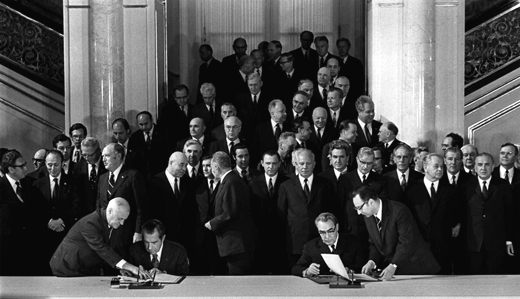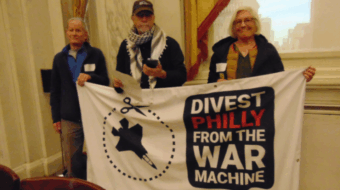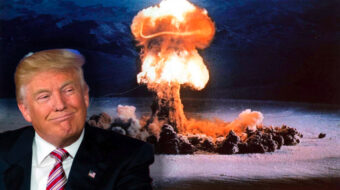
On this date in 1972, the Anti-Ballistic Missile (ABM) Treaty was signed by the U.S. and USSR. The two countries agreed not to build defensive missile systems and thus to limit escalation of the nuclear arms race. It was reasoned that if either side deployed defensive missiles, the other would be forced to respond by increasing the number, explosive yield or effectiveness of their offensive nuclear weapons and delivery systems to maintain the balance of nuclear deterrence.
U.S. Pres. Richard Nixon and Soviet leader Leonid Brezhnev signed the treaty at a summit in Moscow. Later that year it was ratified by the U.S. Senate and the Supreme Soviet. Forming part of the Strategic Arms Limitation Talks (SALT), the ABM Treaty entered into force on October 3, 1972.
The treaty barred Washington and Moscow from deploying nationwide defenses against strategic ballistic missiles. In the treaty preamble, the two sides asserted that effective limits on anti-missile systems would be a “substantial factor in curbing the race in strategic offensive arms.”
The treaty originally permitted both countries to deploy two fixed, ground-based defense sites of 100 missile interceptors each. One site could protect the national capital, while the second could be used to guard an intercontinental ballistic missile (ICBM) field. In a protocol signed July 3, 1974, the two sides halved the number of permitted defenses.
The two nations reasoned that limiting defensive systems would reduce the need to build more or new offensive weapons to overcome any defense that the other might deploy. Without effective national defenses, each superpower remained vulnerable to the other’s nuclear weapons, deterring either side from launching an attack first because it faced a potential retaliatory strike. This was the theory of Mutual Assured Destruction (MAD), by which the threat of annihilation for both sides would prevent either side from “going nuclear” in the event of a conflict.
Pres. Jimmy Carter furthered nuclear reductions with the SALT II Treaty, signed with Brezhnev in Vienna on June 18, 1979. It was Carter’s main goal, as stated in his Inaugural Address, that nuclear weapons completely disappear from the world. This treaty never passed Congress, however, owing to the international struggle over Afghanistan; the bellicosity between the two great nuclear superpowers ramped up again.
During the 1980s, Pres. Ronald Reagan promoted his Strategic Defense Initiative (also known as Star Wars), launching a new phase of the arms race. Then Soviet leader Yuri Andropov said that “It is time [Washington] stopped… search[ing] for the best ways of unleashing nuclear war…. Engaging in this is not just irresponsible. It is insane.” According to some historians, the American push toward intensified arms spending forced the USSR to respond in kind, which diverted resources from domestic priorities and essentially bankrupted the country.
On December 13, 2001, Pres. George W. Bush, arguing that post-Cold War Washington and Moscow no longer needed to base their relationship on their ability to destroy each other, announced that the U.S. would withdraw from the ABM Treaty. Bush was now more concerned with developing defenses against possible terrorist or “rogue-state” ballistic missile attacks. The U.S. withdrawal took effect June 13, 2002 and the treaty is no longer in force.
Arms spending proceeds apace. According to some estimates, the U.S. devotes as much on its military budget as the whole rest of the world combined. Who is going bankrupt now?
Adapted from peacehistory.org, Arms Control Assn., Wikipedia and other sources.
Photo: President Nixon and Soviet leader Leonid Brezhnev affix their signatures to the Strategic Arms Limitations agreement in Vladimir Hall of the Kremlin, Moscow, May 26, 1972. (AP Photo)










